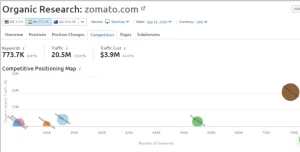Step by Step Guide to Increase CRO for Paid Campaigns
Conversion Rate Optimization (CRO) is crucial for brands as it helps maximise their marketing investments by improving the efficiency and effectiveness of their campaigns, ultimately driving more conversions and revenue.
Sources report that best websites have conversion rates of 11% or more. The top 25% of websites confirm the conversion rate of 5.31% and the top 10% boast conversion rates of 11%.
A conversion rate that falls within 0 to 5 is good because it allows you to lower the customer acquisition costs. You get more value from the visitors and the users you already have.
Let us read in detail what is CRO and steps to increase CRO for paid campaigns.
What is Conversion Rate Optimisation?
Conversion rate optimization (CRO) is making website and marketing campaigns more effective at getting visitors to take the desired action, such as buying something, signing up for a newsletter, or downloading a white paper.
CRO involves understanding how users behave on your website and marketing campaigns, testing different changes to see what works best, and making data-driven decisions to improve conversion rates.
Example of Conversion Rate Optimisation
Amazon is a prime example of a brand that excels in Conversion Rate Optimization (CRO). Here are some specific strategies they employ:
Personalised Product Recommendations:
Amazon leverages customer browsing history, previous purchases, and behaviour data to provide customised product recommendations.

These recommendations are strategically placed throughout the website, including the homepage, product pages, and shopping cart. By tailoring suggestions to individual users’ preferences, Amazon significantly increases the chances of conversion.
Customer Reviews and Ratings:
Amazon encourages customers to leave product reviews and ratings. These user-generated reviews act as a social proof and help potential buyers make informed decisions.
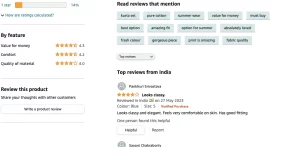
The presence of honest and detailed feedback builds trust, reduces hesitation, and encourages fast decision making ultimately leads to higher conversion rates.
Streamlined Checkout Process:
Amazon has perfected its checkout process to be quick, easy, and secure. They have implemented features like one-click purchasing, saved payment methods, and address autofill to minimise friction and reduce cart abandonment.
By simplifying the checkout process, Amazon eliminates unnecessary steps, making it more convenient for customers to complete their purchases.
A/B Testing and Data Analysis:
Amazon extensively conducts A/B testing to evaluate different variations of its website elements, such as button placements, colour schemes, and call-to-action wording.
Analysing the performance data, they identify the most effective design choices that drive higher conversion rates and continuously optimise their website based on the findings.
Cross-Selling and Upselling:
Amazon effectively employs cross-selling and upselling techniques to increase average order value. They recommend related or complementary products on product pages and during checkout.

By showcasing relevant items that align with the customer’s interests or needs, Amazon encourages additional purchases, leading to higher revenue per customer.
Step-by-Step guide on how to increase CRO for paid campaigns
Follow these steps to increase CRO for Paid Campaigns:
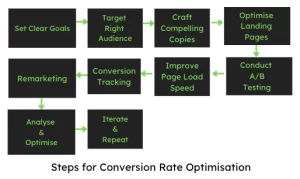
Set Clear Goals:
Define specific conversion goals for your paid campaigns, whether driving sales, generating leads, or increasing sign-ups. Clear goals provide a focus and guide your optimization efforts.
Target the Right Audience:
Identify your target audience based on demographics, interests, and behaviours. Use audience targeting options available on advertising platforms to reach the most relevant users more likely to convert.
Craft Compelling Ad Copies:
Create persuasive and engaging ad copies that highlight the unique value proposition of your products or services. Use compelling headlines, clear calls-to-action, and relevant keywords to grab attention and entice users to click.
Optimise Landing Pages:
Design dedicated landing pages that align with your ad messaging. Ensure your landing pages have a clear and visually appealing layout, concise and persuasive content, prominent call-to-action buttons, and easy-to-fill forms for lead generation.
Conduct A/B Testing:
Test different variations of your ad copies, landing pages, and call-to-action buttons using A/B testing. Compare performance metrics such as click-through rates (CTR), bounce rates, and conversion rates to identify the most effective elements and iterate for better results.
Improve Page Load Speed:
Slow-loading pages can lead to higher bounce rates and lower conversions. Optimise your website’s loading speed by compressing images, leveraging browser caching, and minimising unnecessary scripts to provide a seamless and fast user experience.
Implement Conversion Tracking:
Set up conversion tracking pixels or codes to accurately measure and attribute conversions to your paid campaigns. This data will help you identify high-performing campaigns, keywords, or ads and allocate your budget more effectively.
Leverage Remarketing:
Implement remarketing campaigns to re-engage users who have previously shown interest in your products or services. Show targeted ads to these users across various platforms to remind them and encourage them to convert.
Analyse and Optimise:
Continuously analyse campaign performance data to identify areas of improvement. Monitor critical metrics like conversion rates, cost per conversion, and return on ad spend (ROAS). Make data-driven decisions to optimise your campaigns further.
Iterate and Repeat:
CRO is an ongoing process. Keep refining your campaigns based on data, user feedback, and industry trends. Experiment with new strategies, try different approaches and stay up-to-date with the latest digital marketing practices to continue increasing your conversion rates.
Read: D2C Advertising Strategies to Scale your Brand
Benefits of Conversion Rate Optimisation
After reading conversion rate optimisation guide, you can read further to know several key benefits of Conversion Rate Optimization (CRO) for brands:
Increased Conversion Rates:
CRO helps you get more people to do what you want on your website, such as buy something, sign up for a newsletter, or fill out a form.
By making changes to your website or marketing campaign, you can improve the user experience, remove obstacles, and get more people to act.
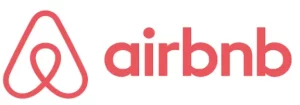
One brand example that experienced increased conversion rates after implementing CRO is Airbnb. The brand continuously optimised its website, user interface, and booking process. Airbnb significantly improved its conversion rates, resulting in successful bookings and revenue growth.
Another brand HubSpot meticulously used A/B testing, landing page optimization, and personalised content strategies, and achieved a significant boost in conversion rates, leading to increased lead generation and more substantial customer acquisition. Their CRO efforts played a vital role in driving business growth.
Higher Return on Investment (ROI):
CRO allows you to make the most out of your marketing investments. By improving conversion rates, you effectively increase the value you get from your existing traffic and advertising efforts.
This results in a higher ROI as you generate more conversions without necessarily needing to attract additional visitors.
Nykaa experienced higher ROI after implementing Conversion Rate Optimization (CRO). It is a leading online beauty and cosmetics retailer. By optimising their website’s user experience, implementing persuasive copywriting techniques, and streamlining the checkout process, Nykaa saw a significant boost in their ROI.

The CRO efforts by Nykaa led to increased conversions, improved customer satisfaction, and stronger revenue growth, making them a standout success in the Indian e-commerce landscape.
Enhanced User Experience:
CRO involves studying how users interact with your website, conducting tests to see what works best, and making changes based on the data. By optimising your website’s design, navigation, and content, you can create a more engaging, user-friendly experience.
This enhances overall satisfaction, builds trust, and encourages visitors to take the desired action.
Flipkart is one of India’s largest e-commerce platforms that enhanced customer experience through CRO strategies. The brand optimised its website’s design, simplified navigation, and improved page load speed.

Flipkart created a seamless and intuitive shopping journey for their customers, resulting in higher customer satisfaction, increased engagement, and improved conversion rates. Their commitment to CRO has solidified their position as a trusted and user-friendly online marketplace in India.
Better Customer Insights:
Throughout the CRO process, you gain valuable insights into your target audience’s preferences, behaviours, and motivations. You can better understand your customers by analysing user data, conducting user testing, and monitoring conversion funnels.
These insights can inform your overall marketing strategy, product development, and customer engagement initiatives.
Competitive Advantage:
Implementing CRO effectively gives you a competitive edge. You stand out from your competitors by consistently improving your website’s performance, user experience, and conversion rates.
A well-optimised website attracts more customers and fosters loyalty, as users are more likely to return to a site that delivers a seamless and satisfying experience.
Zomato is a popular food delivery and restaurant discovery platform. By optimising its website and mobile app experience, implementing personalised recommendations, and simplifying the ordering process, Zomato differentiated itself from competitors.
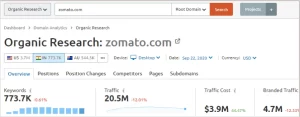
The improved user experience, enhanced convenience, and increased conversions propelled Zomato ahead in the market, allowing them to establish a strong position and become a go-to platform for food-related services.
Their CRO efforts played a significant role in gaining a competitive edge and attracting a more extensive user base.
Cost Savings:
CRO can lead to cost savings in various ways. By optimising conversion funnels and reducing cart abandonment rates, you maximise the value of your existing traffic and lower customer acquisition costs.
Through A/B testing and data analysis, you can identify and eliminate ineffective marketing strategies, allocating resources to more profitable campaigns.
Conclusion
This comprehensive guide has provided a step-by-step roadmap to increase Conversion Rate Optimization (CRO) for your paid campaigns. By implementing the strategies and techniques outlined, you can enhance your ad copies, optimise landing pages, conduct A/B testing, and leverage data-driven insights to maximise conversions and drive better results.
Take advantage of the opportunity to take your campaigns to the next level! Connect with us at hello[at]noboruworld.com to get started and unlock the full potential of your paid campaigns. Let’s supercharge your conversions together!
FAQ
Why is CRO important for my business?
CRO is important because it helps you get more value from your website traffic and marketing campaigns. You can make more money from your existing traffic, acquire more customers, and grow your business by improving your conversion rates.
How long does it take to see results with CRO?
It depends on a few things, such as how complex your website is, how much traffic you get, and how much optimization you need. CRO is an ongoing process requiring you to monitor, test, and make changes over time. You may see results in weeks or months, but the best results come from continuous optimization.
What are some standard CRO techniques to consider?
Some common CRO techniques include A/B testing, heatmaps and user recordings, user feedback surveys, conversion funnel analysis, landing page optimization, persuasive copywriting, and improving website load speed. These techniques help identify areas for improvement, test different variations, and enhance the user experience to boost conversions.
How can I measure the success of my CRO efforts?
To calculate the success of your CRO efforts, track key performance indicators (KPIs) such as conversion rates, bounce rates, click-through rates, average order value, and revenue per visitor. Use analytics tools and conversion tracking to gain insights into user behaviour and monitor the impact of your optimizations. Regularly review and analyse these metrics to gauge the effectiveness of your CRO strategies.

